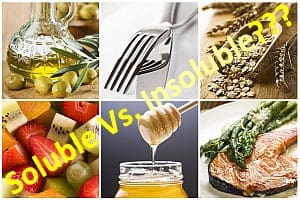statFor some women, it's about making an elegantement at special events or being a couple…

Soluble Versus Insoluble Fiber: What’s the Difference?
 Dietary fiber is a very important component of any healthy diet. Technically, fiber refers to the portions of plants that are edible but that resist digestion. Increased dietary fiber has been shown to protect the body against many diseases (including heart disease), to improve blood sugar levels, and to prevent constipation. Fiber even aids in weight management because it has fewer calories on a volume basis than most other foods, and because it slows digestion, meaning that you’ll feel satisfied longer after a meal high in fiber. People who eat high-fiber meals may also feel full faster and eat less. Most nutritionists recommend that the average adult consume 20 to 35 grams of fiber per day, or 10 to 13 grams per 1,000 dietary calories.
Dietary fiber is a very important component of any healthy diet. Technically, fiber refers to the portions of plants that are edible but that resist digestion. Increased dietary fiber has been shown to protect the body against many diseases (including heart disease), to improve blood sugar levels, and to prevent constipation. Fiber even aids in weight management because it has fewer calories on a volume basis than most other foods, and because it slows digestion, meaning that you’ll feel satisfied longer after a meal high in fiber. People who eat high-fiber meals may also feel full faster and eat less. Most nutritionists recommend that the average adult consume 20 to 35 grams of fiber per day, or 10 to 13 grams per 1,000 dietary calories.
There are two kinds of fiber—soluble and insoluble. Soluble fiber dissolves in water to create a kind of gel that expands in the stomach, coats it, and slows down digestion. This slower digestion time affects blood sugar levels and is suspected of having a beneficial effect on insulin sensitivity, which may help to prevent or control diabetes. Soluble fiber also lowers “bad” (LDL) cholesterol levels because its presence interferes with the absorption of dietary cholesterol. Natural sources of soluble fiber include oats and oatmeal, lentils, apples, oranges, strawberries, pears, blueberries, nuts, flax seeds, beans, dried peas, psyllium, celery, cucumber, and carrots.
Insoluble fiber does not dissolve in water, and passes through the digestive tract in pretty much its original form. But insoluble fiber is also valuable to intestinal health because it keeps the intestines clean. This helps to prevent constipation and hemorrhoids, and has been associated with a lower risk of developing type 2 diabetes. The bran layer of cereal products is the largest and most common natural source of insoluble fiber. Whole wheat, whole grains, nuts, wheat bran, barley, couscous, brown rice, and bulgur are great examples. Fruits that contain insoluble fiber (especially in their edible skins) include cherries, raisins, grapes, rhubarb, oranges, melons, dates, pineapples, prunes and berries. Vegetables that contain insoluble fiber include turnips, beets, cucumbers, onions, sprouts, celery, cauliflower, cabbage, Brussels sprouts, carrots, leafy greens, broccoli, green beans, tomatoes, eggplant, bell peppers and corn.
As is the case with almost all nutrients, it’s best to get your recommended daily allowance of both soluble and insoluble fiber through your normal diet. However, fiber supplements such as psyllium are also available for those who have difficulty consuming enough fiber during the normal course of the day. While most dieticians don’t believe you have to worry much about the “proper balance” of soluble and insoluble fiber, a ratio of 1:3 (soluble to insoluble) is often cited as ideal.
If you’re accustomed to a diet that includes large amounts of processed foods, there are several quick and easy ways to add more fiber to your meals. Consider starting your day with oatmeal or a bran cereal. Try snacking on raw vegetables or whole fruit (skip the fruit juice). Replace your white bread with whole grain breads. “Eat vegetarian” at least once a week. You’ll be surprised at how the little changes add up!




